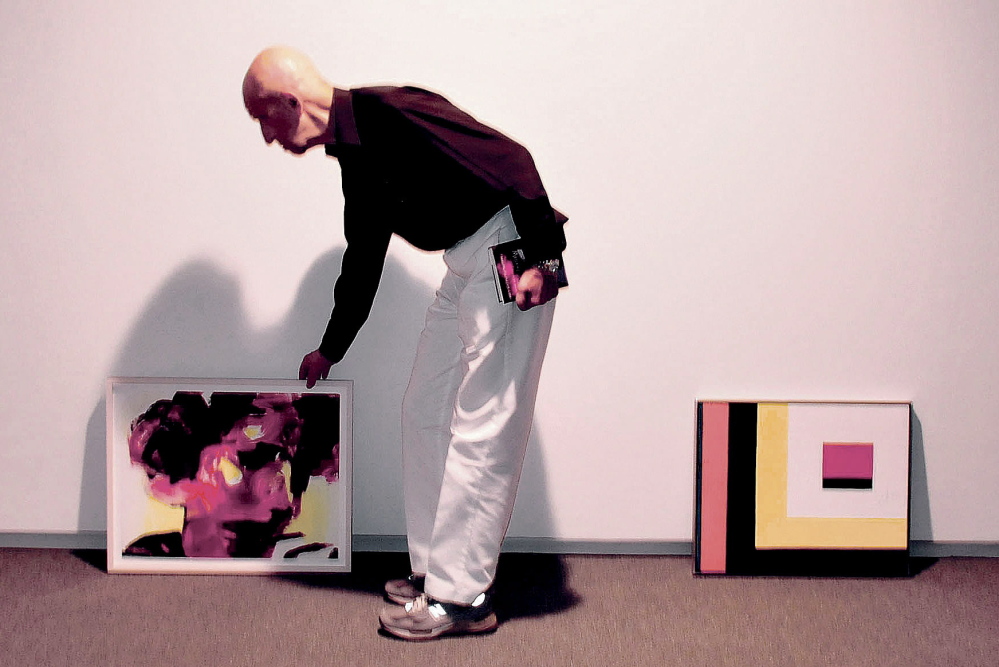WATERVILLE — It may have seemed like an obvious choice in hindsight, but Alex Katz’ decision to hang Nabil Nahas’ dark sculpted acrylic canvas on a central interior wall of the Colby College Museum of Art felt inspired to museum director Sharon Corwin.
“He has such a distinctive vision, and he understands space so well,” Corwin said, stepping back to appraise Katz’ curatorial instincts. “And he’s always right.”
We know Alex Katz as a painter and summer resident of Maine, and longtime benefactor of the Colby College Museum of Art. The museum owns nearly 900 Katz works, and shows them in regularly changing galleries dedicated to the artist.
This summer, we see Katz as curator. Through the Alex Katz Foundation, he’s given more than 450 modern and contemporary works to the museum since 2004. Several dozen are on view in “An Artist’s Gift.” The show says much about his taste as a consumer of contemporary culture and his vision for spotting a gallery.
This past Monday, Katz drove up from Lincolnville, arriving at the museum around 9 a.m. By noon, his work was done, some 70 paintings laid out over two floors. He buzzed through the galleries, making quick decisions without overthinking.
“It’s all just instinct,” he said. “Each painting is comfortable in its own space. You have to get the right paintings in the right space. And you don’t know until you do it.”
Corwin and her colleague Diana Tuite tagged along as the artist picked out paintings. They took notes. Gallery assistants snapped photos to remember what went where.
Katz moved a few things around, but seemed to operate without doubt or second thoughts. His confident decision-making impressed the curators, who are trained to give thoughtful consideration to every angle associated with a piece of art, its location in a gallery and how paintings relate to one another. What took Katz three hours might have taken the curators three days. They think too much, he said, and trust their book smarts more than they trust their guts.
“You come at it from the art history perspective,” Katz told them. “I come at is as an artist. Ideas — they’re OK to start with.”
Colby has shown Katz Foundation paintings regularly. This is the first time the museum has shown so many at once, Corwin said, noting that Katz has shaped Colby’s collection with his gifts of modern and contemporary art. He’s given dozens of works by early-20th-century modernists like Marsden Hartley and Charles Burchfield, as well as emerging and ascending artists.
He buys works by his generational peers and by artists who need a career boost. Katz scouts art in in New York and in his travels. He buys what he likes, and supports artists he knows and is rooting for. “When an artist is two years out of art school, everything is great. When an artist is five years out of art school, it’s hell,” Katz said. “Every little bit of encouragement helps.”
He sometimes consults with Corwin. Sometimes he surprises her. As a result, Colby rotates an always fresh collection of contemporary art.
Eight Hartley paintings are on view, as well as a drawing. A small Maine landscape, painted in 1908, is the latest addition, arriving in time for inclusion in the summer show. “This has to be one of the largest Hartley collections anywhere,” Katz said, admiring the paintings he had just laid out, as well as his decision to buy such a concentration of work by an artist so important to Maine and American modernism.
Katz lingered over the Hartleys, making sure a painting of the Bavarian Alps that Hartley completed in 1933 made sense near a Vinalhaven painting from three years later.
They did. His artist’s instinct did not betray him.
Send questions/comments to the editors.




Comments are no longer available on this story